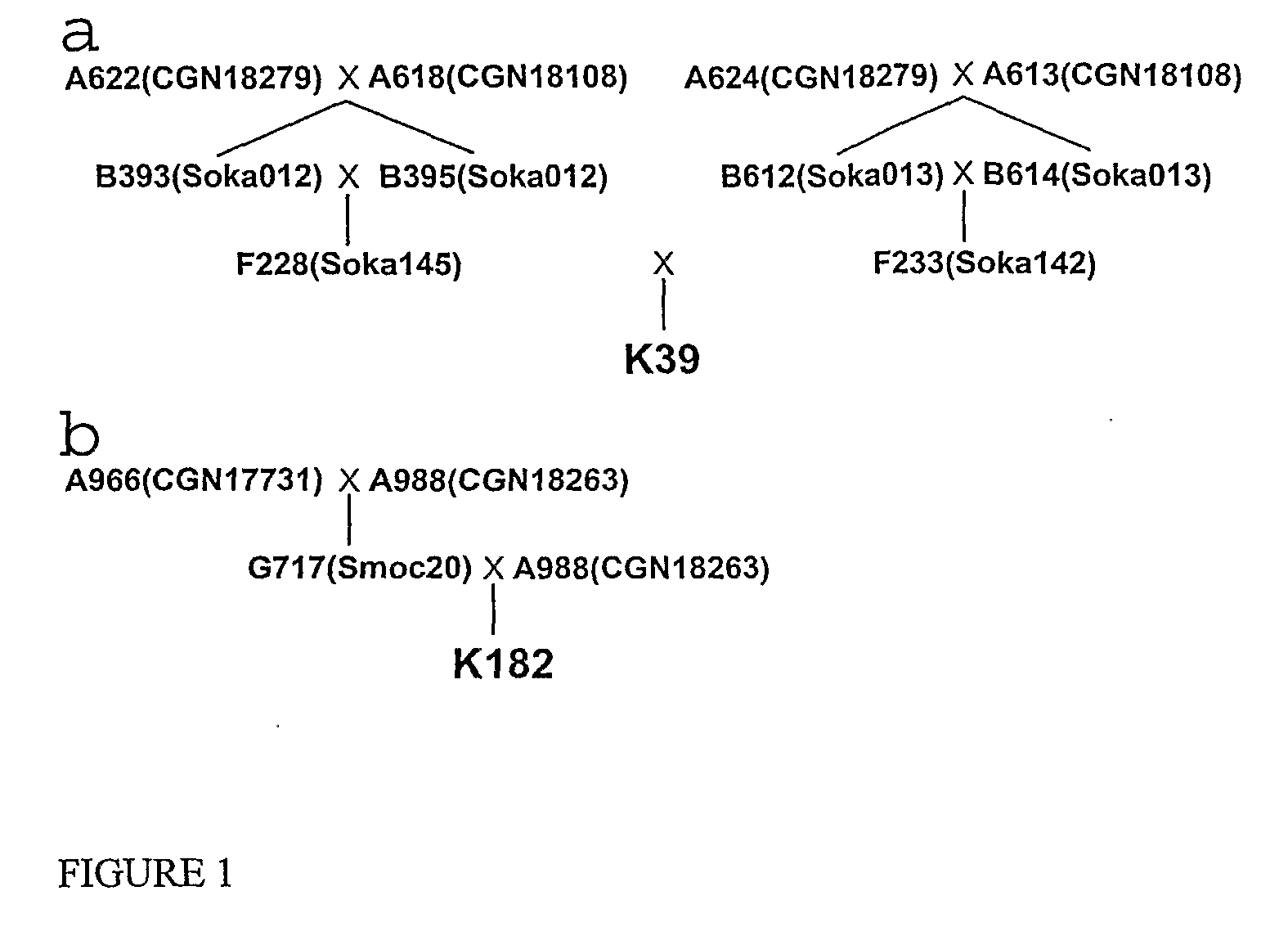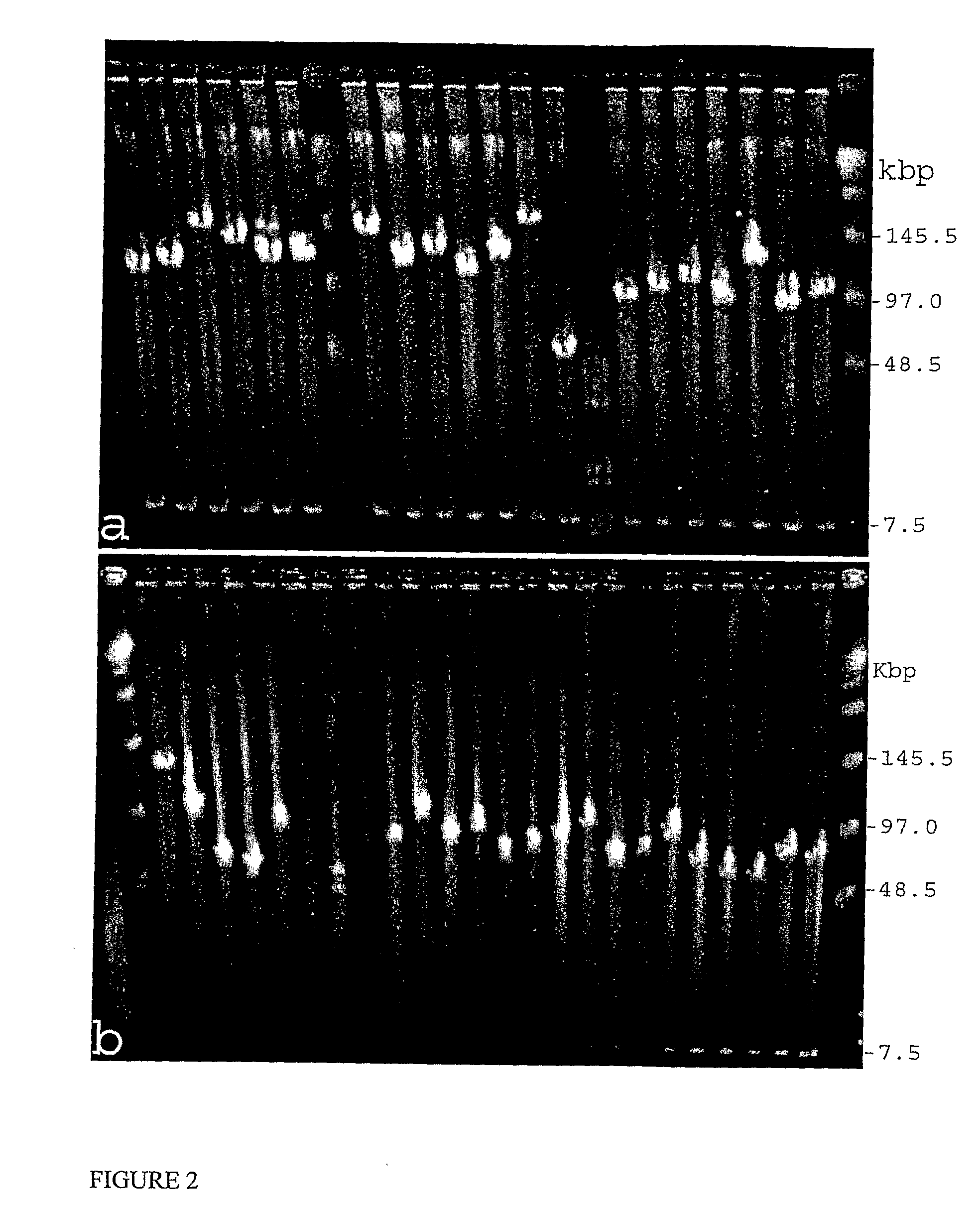Late blight resistance genes and methods
- Summary
- Abstract
- Description
- Claims
- Application Information
AI Technical Summary
Benefits of technology
Problems solved by technology
Method used
Image
Examples
example 1
Construction of Bac Libraries from the Wild Potato Species Solanum okadae and Solanum mochiquense and the Identification of Clones Near Late Blight Resistance Loci
[0133]a. Plant Materials
[0134]The pedigrees of the plants used to construct the two BAC libraries are shown in FIG. 1. The S. okadae plant K39 is a transheterozygote carrying both Rpi-oka1 originally from the parent A618 and Rpi-oka2 from A624 (Foster et al. unpublished data). The S. mochiquense plant K182 is heterozygous for Rpi-mcq1 (formerly named Rpi-moc1; Smilde et al. 2005) and was obtained from a BC1 population.
b. Preparation of High-Molecular-Weight Insert DNA
[0135]A method used for high-molecular-weight (HMW) DNA preparation was slightly modified from Liu and Whittier (1994) and Chalhoub et al. (2004). Plant materials were grown on Murashige and Skoog (MS) medium without sucrose in vitro and young leaf tissues were harvested and stored at −80° C. Twenty grams frozen leaf tissue was used to prepare DNA plugs contai...
example 2
Identification, Mapping and Cloning of Rpi Genes from Solanum okadae and S. neorossii
[0143]a. Plant Growth Conditions
[0144]Seed of 12 Solarium okadae and 4 S. neorossii accessions (Table 1b) was obtained from the Centre for Genetics Resources in Wageningen, the Netherlands (CGN). Seed was surface sterilised in 70% ethanol for 1 minute, disinfected with 1.5% hypochlorite for 5 minutes, rinsed 3 times in sterile distilled water and placed on solid MS (murashige and Skoog) medium (2% agarose) containing 3% sucrose for germination. Germinated seedlings were transferred to glasshouse facilities and treated regularly with fungicides and pesticides to control thrips, aphids, spider mites, powdery mildew and early blight (Alternaria solani).
b. Phytophthora infestans Strains, Inoculation and Pathotest Scoring
[0145]P. infestans isolate 98.170.3 (race 1.3.4.10.11; Smilde et al. 2005) was provided by Dr David Shaw at Bangor University, UK. Isolates 90128 (race 1.3.4.7.8.9.10.11), IPO-complex (...
example 3
Mapping and cloning Rpi-oka1 and Rpi-nrs1 using a Candidate Gene / Allele Mining Approach
[0181]To date, cloning of R genes is typically done through a positional cloning strategy. Once a functional gene is cloned from a specific R locus, one can try to clone functional alleles from the same or different species in order to determine allele frequency and allelic variation at a given locus. Here we demonstrate that NBS profiling (Linden et al., 2004) when combined with bulked segregant analysis (BSA) (Michelmore et al., 1991) is a powerful tool to generate candidate gene markers which can predict the position of the R locus under study and in doing so form a starting point for the cloning of the gene through a functional allele mining strategy.
Plant Material
[0182]Accessions of Solanum okadae and Solanum neorossii were requested from the Centre of Genetic Resources (CGN) in Wageningen, The Netherlands. Following screening with Phytophthora infestans, resistant genotypes from specific acc...
PUM
| Property | Measurement | Unit |
|---|---|---|
| Fraction | aaaaa | aaaaa |
| Fraction | aaaaa | aaaaa |
| Fraction | aaaaa | aaaaa |
Abstract
Description
Claims
Application Information
 Login to View More
Login to View More - R&D
- Intellectual Property
- Life Sciences
- Materials
- Tech Scout
- Unparalleled Data Quality
- Higher Quality Content
- 60% Fewer Hallucinations
Browse by: Latest US Patents, China's latest patents, Technical Efficacy Thesaurus, Application Domain, Technology Topic, Popular Technical Reports.
© 2025 PatSnap. All rights reserved.Legal|Privacy policy|Modern Slavery Act Transparency Statement|Sitemap|About US| Contact US: help@patsnap.com



